KIA Magentis vehicles equipped with a manual transmission are equipped with a dry single-plate clutch with a central diaphragm spring
The clutch is located between the engine and the gearbox and is designed to disconnect and connect the flywheel located on the engine crankshaft and the input shaft of the gearbox.
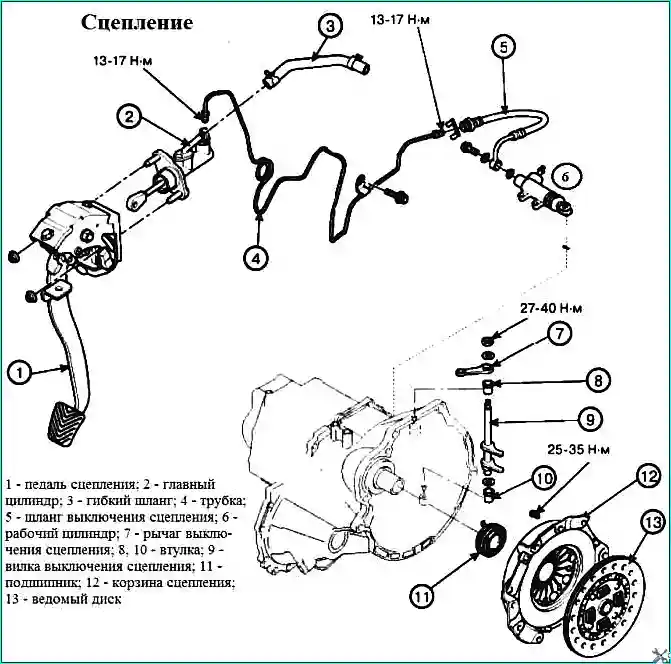
The clutch consists of a driven (friction) disk, a clutch housing with a pressure plate and a diaphragm spring, and a clutch release mechanism.
The pressure plate is mounted in a stamped steel casing attached with six bolts to the engine flywheel.
The driven disk is mounted on the splines of the primary shaft of the gearbox and is clamped by a diaphragm spring between the flywheel and the pressure plate.
The clutch release bearing is mounted on a guide sleeve pressed into the clutch housing and moves along the sleeve with a fork, which in turn is actuated by the slave cylinder of the clutch release hydraulic drive.
The clutch release hydraulic drive includes the following:
- - clutch release master cylinder installed in the engine compartment on the front shield;
- - slave cylinder located on the gearbox housing;
- - pipeline consisting of a tube and an intermediate hose connecting the master cylinder with the slave cylinder;
- - clutch pedal, the bracket of which is attached to the body. The pedal returns to its original position with a spring.
The master cylinder is connected by a hose to a reservoir installed on the master brake cylinder (the reservoir is common for both master cylinders).
The hydraulic clutch release drive uses brake fluid. Adjustment of the clutch release drive during operation is provided.
Technical data
Clutch drive - Hydraulic
Diameter of friction linings (outer x inner), mm 225x150 (2.5 l); 215x145 (2.0 l)
Clutch housing installation load, N 4500–4900 (2.0 l); 5400–5800 (2.5 l)
Master cylinder inner diameter, mm 20.64
Slave cylinder inner diameter, mm 15.87
Adjustment data
Clutch disc thickness, mm 8.3–8.9 (2.5 l); 8.2 – 8.8 (2.0 l)
Clutch pedal installation height, mm 180.5±0.3
Clutch pedal free travel, mm 6–13
Clutch pedal travel, mm 150
Minimum permissible distance to rivet heads at maximum wear of clutch disc friction linings, mm 0.3
Difference in height of diaphragm spring ends, mm 0.5
Clutch piston to slave cylinder clearance, mm 0.15
Clutch piston to master cylinder clearance, mm 0.15
Recommended lubricants
Elements - Lubricant
Clutch release bearing and fork support contact surface release bearing - CASMOLY L 9508
Inner surface of the clutch release bearing - CASMOLY L 9508
Inner surface of the clutch release cylinder, piston and seals - DOT 3 brake fluid
Clutch disc splines - CASMOLY L 9508
Inner surface of the clutch master cylinder, piston and seals - DOT 3 brake fluid
Clutch master cylinder plunger, pin with head and hole for cotter pin and washer - SAE J310a, NLGI №2
Clutch pedal shaft and bushings - SAE J310a, NLGI №1
Clutch release fork - CASMOLY L 9508
Gearbox input shaft splines - CASMOLY L 9508
Tightening torques, Nm
Clutch pedal bracket 25–35
Clutch master cylinder mounting bolt 8–12
Clutch pipe mounting union nuts 12–16
Clutch release cylinder mounting bolt 15–22
Clutch release cylinder joint mounting bolt 25
Clutch housing (2.0 l) 15–22
Clutch housing (2.5 l) 20–27
Clutch master cylinder pusher lock nut 10–15
Clutch master cylinder reservoir 8–10
Ignition Interlock Switch 8–10
Bleeding the Clutch Hydraulic System
When bleeding, add only the clean fluid recommended by the manufacturer.
Do not mix different brands of brake fluid.
Brake Fluid: SAE J1703 (DOT 3)
The fluid used in the hydraulic system dissolves paint and plastic, so if the fluid gets on the paintwork of the car, wash it off with a more water.
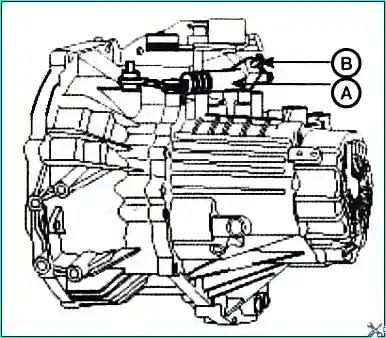
Loosen the bleeder nipple in the clutch release cylinder and attach a hose to it.
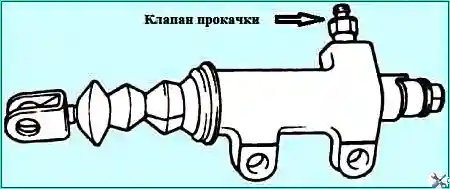
Place the other end of the hose in a glass container of sufficient volume.
Slowly press the clutch pedal.
With the clutch pedal depressed, loosen the bleeder nipple and bleed air from the hydraulic system.
Tighten the bleeder nipple and release clutch pedal.
Repeat the operations until the brake fluid comes out without air bubbles.
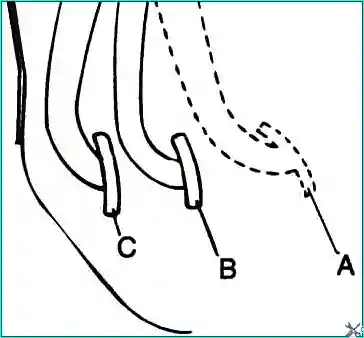
Quickly pressing the clutch pedal again in the area (B – C) can cause the push rod to come out of the clutch cylinder body during bleeding.
You should press the clutch pedal only after it has returned to the upper position (A).
Adjusting the clutch pedal
Measure the distance from the front surface of the pedal to the carpet coatings.
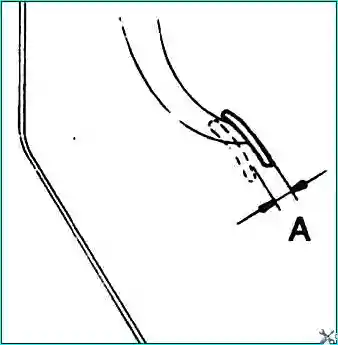
Press the clutch pedal by hand until you feel a noticeable resistance and measure the free play.
Clutch pedal free play (A): 1–3 mm
If the clutch pedal free play does not correspond to the required value, adjust it.
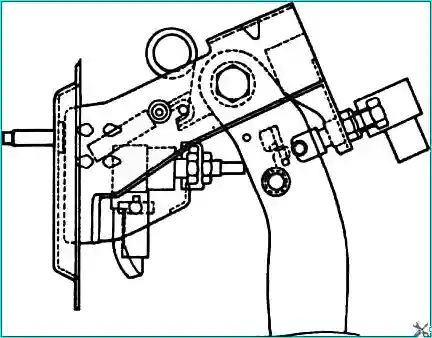
Loosen the lock nut and turn the bolt to adjust the clutch pedal free play, then tighten the lock nut.
After adjustment, tighten the bolt until it reaches the pedal stop, then tighten the lock nut.
Rotate the plunger until the desired free play is achieved, then tighten the lock nut.
When adjusting the mounting height or free play of the clutch pedal, be careful not to move the plunger toward the clutch master cylinder.
After completing the adjustments, check that the distance from the clutch pedal to the floor with the pedal depressed is the desired value.
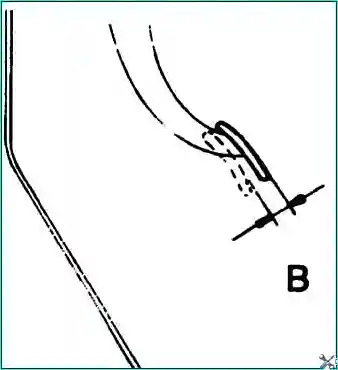
Clutch pedal free play (B): 6–13 mm
If the installation height and free play of the clutch pedal cannot be adjusted, there may be air in the clutch hydraulic system or the clutch master cylinder is faulty.
In this case, bleed the air or disassemble and inspect the clutch master cylinder.
Clutch Troubleshooting
- Probable Cause - Remedy
Clutch slippage (The car does not accelerate when the engine speed increases; the car speed is insufficient; insufficient power on hills):
- - Insufficient clutch pedal clearance - Adjust the clutch pedal clearance
- - Clogged clutch hydraulic system - Clean or replace parts
- - Excessive wear of clutch disc - Replace the clutch disc
- - Seized disc on the splines of the input shaft or oil on the friction linings - Replace the clutch disc
- - Damaged pressure plate or flywheel - Replace the pressure plate or flywheel
- - Weak or broken diaphragm spring - Replace the pressure plate
Difficult to shift gears (gear noise when shifting gears):
- - Excessive clutch pedal clearance - Adjust the pedal clearance clutch
- - Clutch hydraulic fluid leaking - Locate and repair leak
- - Clutch disc worn or corroded - Replace clutch disc
- - Clutch disc excessively distorted - Replace clutch disc
Clutch noise (When clutch is not in use):
- - Clutch pedal clearance too low - Adjust the clutch pedal clearance
- - Excessive wear of the clutch disc - Replace the clutch disc
Noise appears after the clutch is disengaged:
- - Worn or damaged clutch release bearing - Replace the clutch release bearing
Noise appears when the clutch is disengaged:
- - No grease on the surface of the support sleeve - Lubricate the surface of the support sleeve
- - Incorrectly installed clutch release bearing - Repair
Noise appears when the vehicle is driven with the clutch partially engaged:
- - Damaged guide sleeve - Replace the guide sleeve
The clutch pedal is pressed with difficulty:
- - Not enough lubrication in the clutch pedal
- - Not enough lubrication on the clutch disc splines
- - Not enough lubrication on the clutch release shaft lever
- - Not enough lubrication on the front bearing cover - Repair
Gears are difficult to engage or do not engage at all:
- - Insufficient clearance in the clutch pedal - Adjust the clearance in the clutch pedal
- - Defective clutch release cylinder - Repair or replace
- - Excessive runout of the clutch disc - Repair or replace
- - Dirty or rusty splines on the transmission input shaft - Repair
- - Defective pressure plate - Replace the pressure plate clutch
Clutch slippage:
- - Insufficient clutch pedal clearance - Adjust clutch pedal clearance
- - Clutch hydraulic system clogged - Clean or replace parts
- - Clutch disc worn - Replace clutch disc
- - Defective clutch pressure plate - Replace clutch pressure plate
- - Broken clutch release fork mount - Repair
Clutch vibration:
- - Clutch disc warped, worn, or contaminated with oil - Check clutch disc
- - Defective clutch pressure plate - Replace clutch pressure plate
- - Damaged or broken diaphragm spring - Replace pressure plate disc
- - Damaged clutch disc damper spring - Replace clutch disc
- - Loose underframe mount - Repair
Clutch noise:
- - Damaged clutch pedal bushing - Replace clutch pedal bushing
- - Loose mount in clutch housing - Repair
- - Worn or dirty clutch release bearing - Replace clutch release bearing
- - Loose clutch release fork mount - Repair





